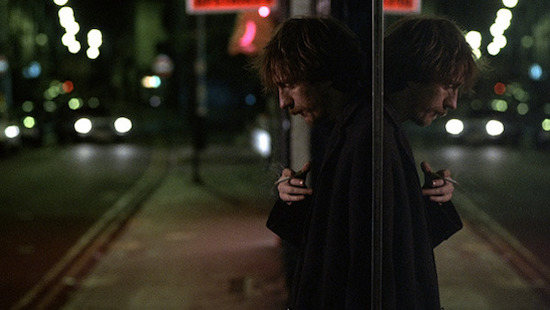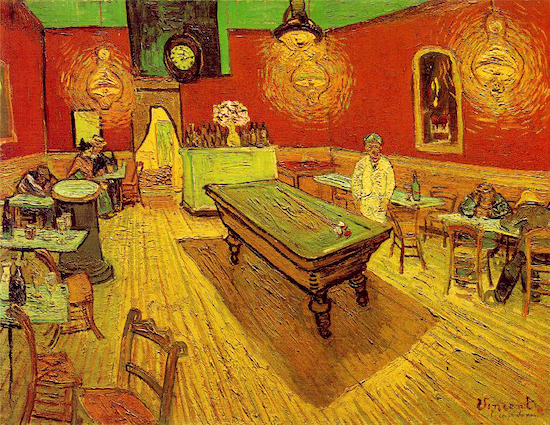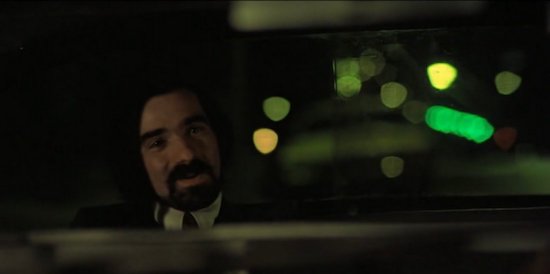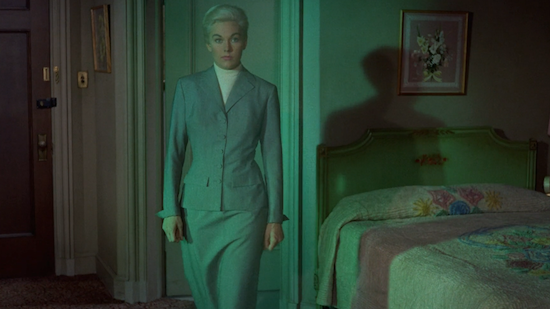A solitary man stands alone in a parking lot, its smooth concrete angles washed in a sickly green light. Moments before, he’d spoken to his estranged wife through a phone hooked up to her peep show booth. They’re separated by a sheet of one-way glass. “I knew these two people,” he begins, before telling her the story of their life together.
“And for the first time, he wished he were far away. Lost in a deep, vast country where nobody knew him. Somewhere without language or streets,” he continues wearily, before telling her the hotel room number where their young son is waiting. The man exits the building and stands alone in an empty parking lot, then slowly turns away and drives off into the night.
This is the ending of Wim Wenders’ Paris, Texas, a film about isolation, loneliness, and loss heaped upon loss. It’s the story of a man who loses his wife and his child twice. For Travis Henderson, family and love are like hooks that snag his skin and threaten to pull him back into himself, his despair, his rage.
Instead, he drifts through vast landscapes of emptiness on a self-imposed exile; through boulders and desert dust, along two-lane highways and swooping flyovers, through empty parking lots dwarfed by looming hotels. It’s either high-noon, a time when the glaring sun obliterates shadows and washes everything in a hazy flatness – or it’s night. Neon motel signs and jukebox chintz glitter with empty distraction. The desert and highways are empty; Travis is drawn to them both.
Paris, Texas is a film with the chill of loneliness running through its veins, but it’s the green-lit parking lot that echos Travis’ anxieties more potently than any other image.

The light’s fluorescent glow offers no warmth; it’s eerie and off-putting. It conjures up images of overgrown industrial lots and dark alleys where bins spill damp garbage. It tantalisingly hints at redemption from loneliness; it apes the warmth of fire, it alludes to civilisation, bustle, warm bodies and closeness, but it symbolises the opposite. In the hotel windows glowing in dusk, there’s nothing but a reminder of a life you’re not a part of. The green-lit parking lot echoes the emptiness of the desert from which Travis emerged, but its close proximity to his estranged family lends his new isolation a deeper sense of perspective.
In her book The Lonely City, Olivia Laing describes Edward Hopper’s Nighthawks as an enduring image of loneliness and hones in on one particular element – the green light. “There is no shade in existence that more powerfully communicates urban alienation than this noxious pallid green, which only came into being with the advent of electricity, and which is inextricably associated with the nocturnal city of glass towers, empty illuminated offices and neon signs.”
It’s no coincidence the barren landscapes that proliferate in Wenders’ works often bear a striking resemblance to the paintings of Edward Hopper: the former was a great fan of the latter. They worked together on Hammett, and in The End of Violence, Wenders includes an evocation of Nighthawks, a painting novelist Joyce Carol Oates once described as “our most poignant, ceaselessly replicated romantic image of American loneliness.”
As with many of Hopper’s paintings, Nighthawks depicts a scene in which no one appears to be communicating. The diner’s window, a sweeping bubble of glass, encases four figures – a couple, a lone man and a counter boy. Sulphur-yellow walls fringed with malachite-green tiles reflect that noxious shade back out into the dark street. The inhabitants’ bodies are closed off from each other, their gazes unfocused and distant. Have they found comfort against the indifference of the city, or is their lack of communication indicative of urban isolation? A terrifying stillness fills the image. To me, it’s the latter.
Though hopper was reluctant to cite loneliness as his muse, his elusive paintings have nevertheless gone on to embody a cinematic kind of American alienation. As an avid cinema-goer, Hopper was himself influenced by the deep shadows and high-contrast lighting seen in film noirs of the time. “When I don’t feel in the mood for painting, I go to the movies for a week or more”, he said. “I go on a regular movie binge.” In turn, his work has gone on to stylistically inspire cinema, and Nighthawks is considered an embodiment of the noir aesthetic.
Hopper’s influence is particularly pervasive in the films of Alfred Hitchcock. The director based the house in Psycho on Hopper’s The House by the Railroad, and his recurring themes of isolation and voyeurism (though not in the prurient sense) are all similarly recurring themes in Hopper’s paintings.
Vertigo, Hitchcock’s loneliest film, introduces that sickly green at a pivotal moment: Scotty is finally confronted with the ghostly image of his deceased lover as she’s brought back to life through a woman who eerily resembles her. He clasps her to himself in a passionate embrace, though the scene pulses with a weird loneliness: the room is saturated with that unnatural green while Bernard Herrmann’s score thunders into a triumphant climax. It’s a sinister subversion of the traditional scene d’amour with a lurking wrongness at its core.
Since Nighthawks, that shade of green has become intrinsically linked to urban alienation. In Scorsese’s Taxi Driver, Travis Bickle – a loner and insomniac – drives his cab endlessly through the night. The angry red of passing taillights merge with electric greens that bleed across the screen like film that’s been exposed to the light. He is repulsed by the sights of downtown New York, yet they compel him; they belong to a world he both despises and craves, and he returns to the neon-charged 42nd street like a moth to a flame.
Ridley Scott also drew inspiration from Hopper’s paintings – specifically, Nighthawks – for the futuristic noir look of Blade Runner, admitting: "I was constantly waving a reproduction of this painting under the noses of the production team to illustrate the look and mood I was after". If you watch the film (or search for a still online), you’ll see the clogged skyline of Scott’s dystopian LA glows with that same shade of green, which glows ominously in a sheet of smog that hovers over the city.

Though American cities and alienation are a popular pairing, this particular hue isn’t confined to films set in the states. In Mike Leigh’s Naked, David Thewlis plays Johnny, a furious Mancunian who wanders the streets at night spitting rage and witticisms at anyone who’ll listen. The palette oscillates between the cold blue light of a lifeless morning to the dirty grey-black of streets at night. The grubby hues of Leigh’s London are more muted than neon-drenched New York or LA, but that nauseous shade remains. It filters through the windows of empty office blocks, and shimmers on the cold night air like a dirty oil slick.
Urban loneliness isn’t exclusive to angry, alienated men, either. In Wong Kar-wai’s In the Mood for Love, two neighbours are brought together when the mutual discovery of cheating spouses sparks an achingly restrained platonic love affair. As in Nighthawks and Hopper’s window paintings, loneliness becomes coiled around colours and viewpoints. Soft steam rising from a bowl of noodles consumed in solitary silence, velvety reds contrast with cold green electric lights, and stolen glimpses through windows and cramped hallways.
Though many directors saw cinematic value in Hopper’s paintings, the association between that particular shade of green and urban alienation can be traced back to an even earlier work: Vincent Van Gogh’s The Night Café, which Hopper biographer Gail Levin claims was a source of inspiration for Nighthawks. The painting’s angle has the skewed perspective of a nightmare, uncomfortably pitching the viewer forward towards a curtained room on the far wall, and those colours – a clash of toxic yellow, blood red and jade evoke a more sinister version of alienation.
Van Gogh, in a letter to his brother, wrote: “I have tried to express the idea that the café is a place where one can ruin oneself, go mad or commit a crime. So I have tried to express, as it were, the powers of darkness in a low public house, by soft Louis XV green and malachite, contrasting with yellow-green and harsh blue-greens, and all this in an atmosphere like a devil’s furnace, of pale sulphur.”

The Night Café represents a different kind of alienation, something sicker and more complete. Even Taxi Driver, a vicious bloodbath of a film, doesn’t come close to the unsettling mania of Van Gogh’s cafe. Disturbingly, it’s a children’s film that more closely hits that mark, and one which has recently been bestowed the title of ‘most influential’ film ever made: The Wizard of Oz.
It’s the first film to ever feature that noxious green. It’s the first mainstream film to feature any green: made in 1939, it triumphantly ushers in glorious Technicolor the moment Dorothy leaves Kansas and steps into a garden of plastic hollyhocks. Each frame from then on is awash with colour: the yellow brick road, glittering slippers as vivid as rubies, and at the centre of it all, a shimmering metropolis of jade-green domes set amid an opiate-laced field of poppies.
There’s that colour again. It twinkles on the horizon, it promises fulfilment, purpose and adventure. A bright, synthetic hue with darkness at its edges. As Dorothy, Tin Man, Scarecrow and Lion hobble through a cavernous hallway that leads towards the Great Wizard of Oz, they learn the Emerald City represents not just hope, but rejection and danger. The glitter and sheen are replaced with shadows, though that sickly green – now wholly sinister – remains.
The Wizard of Oz is underpinned by a feeling of alienation. From the beginning, Dorothy yearns to escape the barren Kansas corn fields and discover a shimmering world ‘over the rainbow’. She has no friends nor any opportunities, though as it turns out, Oz is scarcely better. The riot of colour becomes the poisonous green and red tableau of the Emerald City, and when Dorothy finally meets the wizard, he turns out to be a quivering con man pulling levers from behind a curtain. Dorothy’s final experience of Oz is of disillusionment, and when she clicks her glittering heels together, she gratefully bids farewell to her multicoloured nightmare.
Film noir characteristically depicts the city as a vicious no-man’s-land, a lonely place populated by desperate people, and Oz is no different: Dorothy retreats into the security of her Kansas home after tasting the exciting, but frightening Emerald City. After the war, Americans also flocked to the suburbs for security and escape. But suburbia can be just as vicious, just as lonely – and by the mid-50s, the idyllic land of neat lawns and picket fences was gradually transformed from a blissful American ideal into a world of cold indifference.
Douglas Sirk’s All That Heaven Allows attacks small-minded snobbery and conformity with its portrait of a middle-aged, middle-class woman who falls in love with her gardener. Later, Bryan Forbes’s The Stepford Wives unpicks malignant chauvinism and bland suburban values with its depiction of a town populated by fembots, and later still, David Lynch’s Blue Velvet viciously questions the seemingly wholesome facade of middle American domesticity.

Families turned in towards each other in a self-contained unit that not only excluded others, but often left those within the family feeling imprisoned. The short stories of Raymond Carver evoke the small, quiet struggles of suburban lives, and his blue-collar, liquor-drenched snapshots are filled with private sorrows and loss. The characters in Carver’s stories are firmly working-class, but they could easily be the inhabitants of Hopper’s world of pensive silences, next door neighbours to the Lisbon family in Sofia Coppola’s The Virgin Suicides, or friends of the Rath family in Nunnally Johnson’s The Man in the Gray Flannel Suit.
Though that pallid, urban green is missing, its has been replaced with a new light: the bright, blinding midday sun that glares over rows of cookie-cutter houses fenced off from one another, or else the blue-grey glow of a TV set casting its flickering light into a room of uncommunicative inhabitants. In more contemporary films, this is now the cold white light of a phone or laptop screen glowing in a darkened room.
Green is the colour of loneliness in the big city, but the colour itself isn’t enough, just as cities at night aren’t sole provinces of loneliness. The Night Café, and later The Wizard of Oz were the first to bring alienating malachite green to the canvas and screen respectively, but both works are missing a sense of melancholy, and the ambiguity that allows the viewer to project their own desires and fears onto the image.
Again, Edward Hopper’s influence reaches into the screen. His most sunlit paintings are, as Hitchcock saw, some of his most lonely. The green glow of Nighthawks is supplanted by watery afternoon light; pallid green becomes a cold, pallid blue. A sliver of sunlight inching up the wall brings not warmth but a reminder of the passing of time, and the claustrophobic closeness of the city becomes the equally claustrophobic vastness of endless cornfields and blue sky. The harsh, diagonal shadows cast by the midday sun are evocative of the moody, expressionistic visual style of film noir: it’s the middle of the day, but the lonely essence of the night remains.


